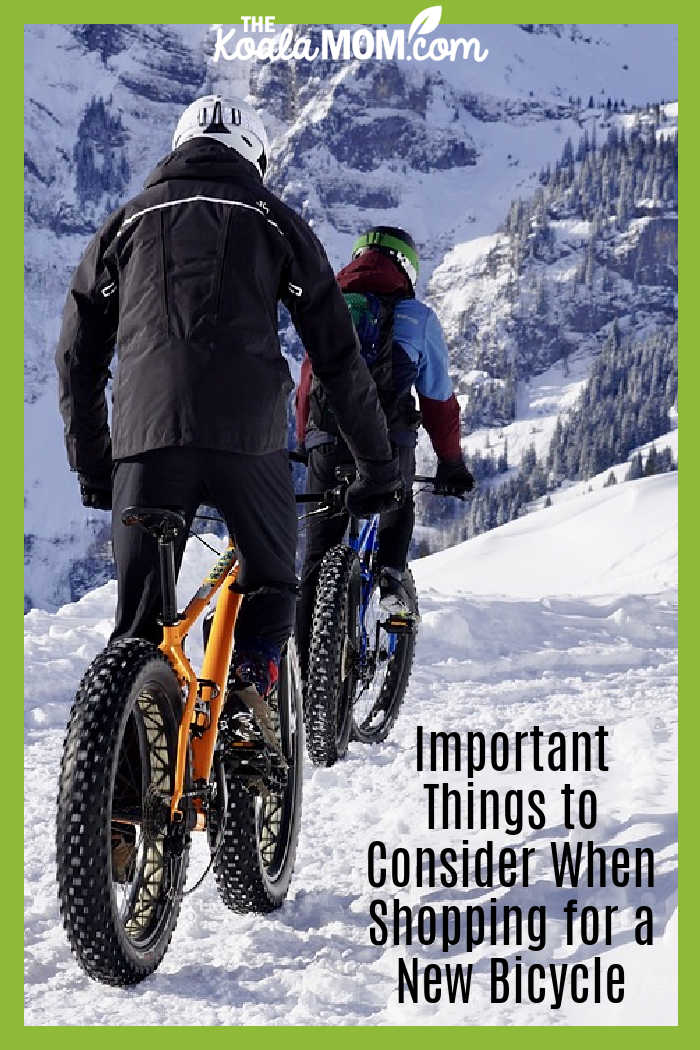Shopping for a new bicycle is an exciting adventure, whether you’re a seasoned cyclist or a beginner looking to embrace the world of cycling. Bikes come in various styles, each designed for different purposes, from leisurely rides through the park to intense off-road adventures. Choosing the right bicycle involves considering several key factors to ensure you get a bike that suits your needs, preferences, and budget.
This comprehensive guide explores the essential things to consider when shopping for a new bicycle to help you make an informed decision.

Frame and Wheel Size and Fit
Choosing the correct frame size is crucial for your comfort and performance. A bike that doesn’t fit properly can lead to discomfort and inefficient riding. Visit a local bike shop or consult sizing charts provided by manufacturers to determine the correct frame size based on your height and inseam. Explore the internet for a bike size chart matching your model of choice.
Choosing the right size of bike is particularly important for children. While it may be tempting to buy a slightly larger bike for a child to grow into, it’s best to adhere to the bike size chart and buy a bike that fits your child now. If your child does outgrow it quickly, you can likely sell it and replace it for them. Riding a bike that is too big for a child can make biking more difficult for them and be a safety concern.
Remember that sizing can vary between manufacturers, so you must check specific sizing recommendations for the bike you’re interested in. Before making a decision, take several bicycles for test rides. Pay attention to how the bike feels, the riding position, and how easy it is to control. Testing different models will help you find the perfect fit.
Historically, 26-inch wheels were the standard for mountain bikes. They offer excellent maneuverability but may not roll smoothly over obstacles like larger wheels. Intermediate in size, 27.5-inch wheels balance maneuverability and roll-over capability. They are a popular choice for many mountain bikers. 29-inch wheels provide enhanced roll-over capability and are known for their stability. They are commonly used on cross-country and trail mountain bikes.
Frame Material
Aluminum frames are lightweight and affordable. They offer a good balance of durability and performance. These frames are a popular choice for entry-level and mid-range bicycles.
Steel frames are known for their durability and ability to absorb road vibrations. They provide a comfortable ride but are heavier than aluminum frames. Steel is often used in touring and commuter bikes.
Carbon fiber frames are the lightest and offer excellent shock absorption. They are commonly used in high-end road and mountain bikes. These frames provide a responsive and efficient ride.
Titanium frames are highly durable and corrosion-resistant. They offer a smooth ride, similar to steel, but with a lighter weight. Titanium frames are found in premium bicycles.
When choosing the best frame material, consider not only how you will be riding your bike but also where you take your bike. Do you lift it frequently onto and off a bike rack or into and out of a vehicle? Can you roll it straight into the garage or do you need to carry it up a flight of stairs to store it?
Brakes and Suspension
Rim brakes, like caliper and cantilever brakes, grip the wheel rims to slow the bike. They are common on road bikes and are easy to maintain. However, they may not provide enough stopping power in wet or muddy conditions.
Disc brakes, including hydraulic and mechanical types, are known for their superior stopping power and consistency in various weather conditions. They are widely used on mountain bikes and are becoming more common on road and hybrid bikes.
If you plan to ride on rough terrain or trails, a bike with front suspension, often called a “hardtail,” can provide enhanced comfort and control. These are common on mountain bikes. Full-suspension bikes have front and rear suspension, providing maximum comfort and control on highly rugged terrain. They are popular among serious mountain bikers.
Components and Gearing
Groupsets refer to the collection of components on your bike, including the gears, brakes, and shifters. High-quality groupsets can significantly impact your bike’s performance. Brands like Shimano and SRAM offer various options, from entry-level to professional-grade.
Consider the terrain you’ll be riding on when choosing your gearing. Bikes with more gears provide a more comprehensive range of options for different landscapes, while single-speed bikes are low-maintenance but may limit your versatility. If you frequently ride in hilly locations, then more gears are preferable. If you are doing more flat touring, then less gears may be suitable.
Kids’ bikes often have fewer gears and simpler designs. As your child gets more comfortable on their bikes and grows into larger bikes, then they can handle more gears and better components.
Accessories and Add-Ons
Consider the accessories you may need for your riding style, such as lights, fenders, water bottle holders, racks, bell, and a bike lock. These additions can enhance your cycling experience. Customize your bike to suit your preferences. You can add features like a comfortable saddle, ergonomic handlebars, or pedals that match your riding style. These personalized touches can make your bike uniquely tailored to your comfort and riding preferences.
Determine Your Riding Style
Consider a city or commuter bike if you plan to use your bicycle for daily commuting. These bikes are designed for efficiency and comfort during urban rides. Look for features like fenders, a comfortable saddle, and adding panniers or a rack for carrying your belongings.
A road bike is an excellent choice for those interested in fast-paced rides on paved roads. These bikes are lightweight and designed for speed. They feature drop handlebars and narrow tires for minimal rolling resistance.
A mountain bike is the way to go if you’re an adventure seeker who loves off-road trails and rugged terrains. These bikes are built to handle rough conditions and provide excellent control. Look for sturdy frames and knobby tires for better traction.
Touring bikes are perfect for long-distance journeys. They are designed for comfort, stability, and carrying extra gear. Touring bikes typically have a more relaxed geometry, making them ideal for extended rides.
Cargo bikes have a longer frame with additional space over the back tire where children can ride safely and comfortably. They are often hybrid bikes and should have disc brakes and more gears to better accommodate the extra weight on board.
Hybrid bikes offer a versatile option for a mix of on- and off-road riding. They are known for their comfortable upright riding position and can handle a variety of terrains. This makes them a popular choice for recreational cyclists.
Maintenance and Upkeep
Bicycles require regular maintenance to ensure they function correctly and remain safe to ride. Learn basic maintenance tasks, such as tire inflation, chain lubrication, and brake adjustments, or have a professional perform regular tune-ups. Proper storage helps protect your bike from the elements and theft. Invest in a sturdy bike lock and consider indoor storage to prolong your bike’s life.
Determine your budget for purchasing a new bike. Be realistic about your financial constraints and explore options that offer the best value within your budget range. Remember that the initial cost of the bike is only one part of the equation—factor in ongoing expenses, such as maintenance, accessories, and any gear or clothing you need.
You’ll also want to consider transporting your bike. While many cyclists ride near their homes, you may also want to drive to a new location to go for a ride, particularly if you enjoy trail biking. A good bike rack for your vehicle will help you easily and safely transport your bike to your ride destination or to a bike shop for repairs. Ensure your bike rack is able to carry the style of bike you wish to purchase.

Shopping for a new bicycle involves considering various factors to choose a bike that suits your riding style, size, and preferences. Whether you’re looking for a bike to commute to work, tackle challenging trails, or enjoy leisurely rides with your kids, evaluating these factors carefully will help you make an informed decision.

No Responses Yet